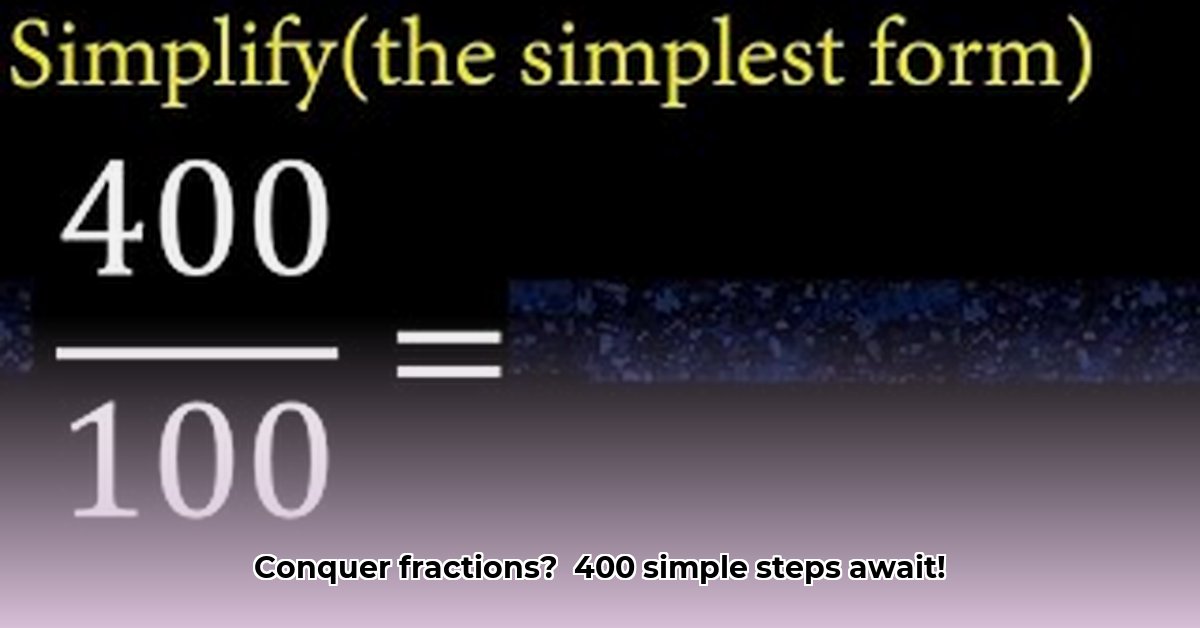
Understanding Fractions: The Building Blocks
Before diving into the complexities of representing 400 as a fraction, let's solidify our understanding of fractions themselves. A fraction represents a part of a whole. Think of a pizza cut into slices: the bottom number (denominator) indicates the total number of slices, while the top number (numerator) shows how many slices you have. For example, 1/2 (one-half) means one slice out of two equal slices.
Writing 400 as a Fraction: The Simplest Approach
The most straightforward way to express 400 as a fraction is 400/1. Here, 400 represents the total number of parts, and 1 represents the whole, or the single unit. This is an improper fraction (where the numerator is larger than the denominator), and it's perfectly acceptable, often serving as a useful starting point. Why is this a good starting point? Because it's a clear and direct representation of the whole number as a fraction.
Expanding Your Horizons: Fractions with Different Denominators
What if we want to express 400 as a fraction with a denominator other than 1? Let's aim for a denominator of 10. To achieve this, we employ a fundamental principle: we multiply both the numerator and the denominator by the same number. In this case, we multiply 400/1 by 10/10, resulting in 4000/10. The value remains unchanged; only the representation has been altered. This principle applies to any desired denominator; simply multiply both the numerator and denominator by the same number. This is crucial for performing operations such as addition and subtraction with fractions. Why is this such a versatile strategy? Because it allows for easy manipulation of fractions to solve various mathematical problems.
Decimals and Fractions: A Two-Way Street
We can also approach this from the perspective of decimals. The number 400 can be written as 400.00. Converting decimals to fractions provides another avenue for representing 400 fractionally.
Let's use a smaller decimal, 0.400, as an illustration. This decimal has three decimal places, indicating it's equivalent to 400/1000. To simplify, we find the greatest common divisor (GCD) of the numerator and denominator. The GCD of 400 and 1000 is 200. Dividing both by 200 simplifies the fraction to 2/5. Simplifying fractions is essential for clarity and efficient mathematical manipulations. Why is simplification so important? Because it provides a more concise and manageable representation of the fraction's value.
Real-World Applications: Why Bother?
Mastering the representation of whole numbers as fractions is immensely valuable. It's a cornerstone of many mathematical operations; it's essential for adding, subtracting, multiplying, and dividing fractions effectively. Moreover, it significantly enhances your overall understanding of numbers and their relationships. This skill is regularly utilized in various fields, such as engineering, finance, and baking. Why wouldn't you want this skill? It's a critical tool for real-world problem-solving.
Mastering Fractions: A Path to Confidence
Understanding how to express whole numbers like 400 as fractions is a key component of mathematical proficiency. Experiment with different methods and approaches until you find what works best for you. The more you practice, the more confident you’ll become.
Effective Teaching Strategies for Fraction Conversion
- Visual Aids: Pictures, diagrams, and manipulative objects provide tangible representations of fractions.
- Interactive Activities: Engaging activities and games make learning both fun and effective.
- Multifaceted Approaches: Catering to diverse learning styles ensures better comprehension.
- Step-by-Step Guidance: A clear, organized approach is essential for effective instruction.
- Consistent Practice: Repetition is key to building confidence and solidifying understanding.
This guide provides a solid foundation for fraction mastery, enabling you to confidently handle fractions—even those involving larger numbers like 400. Remember, consistent practice is the key to unlocking your full mathematical potential.